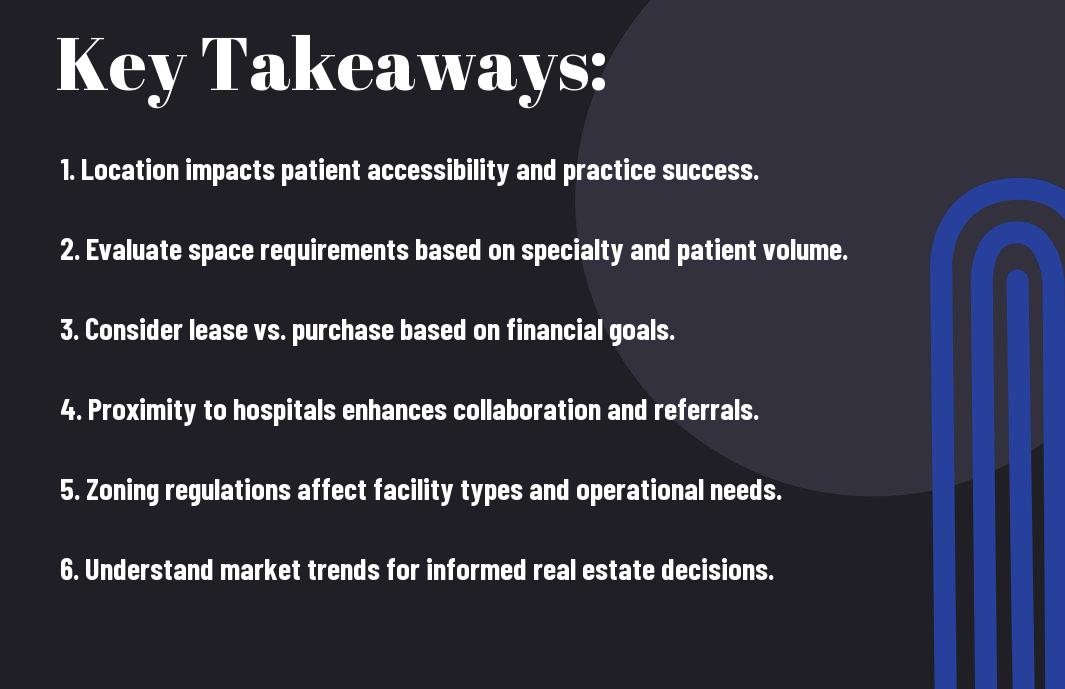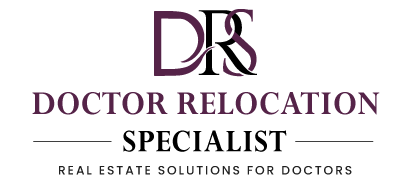Just as you prioritize patient care, understanding the unique real estate needs of healthcare providers is imperative for your practice’s success. Navigating the complexities of healthcare spaces, from location choices to regulatory requirements, can significantly impact your operations and patient experience. This guide will equip you with valuable insights into the factors you need to consider when evaluating your property options, ensuring that you make informed decisions that foster growth and enhance patient services.


The Unique Real Estate Requirements of Healthcare Providers
Before delving into real estate decisions, it’s vital to recognize that healthcare providers operate under specific requirements. Your real estate needs extend beyond mere location; you must consider patient accessibility, compliance with healthcare regulations, and the suitability of the space for your practice’s unique functions. Understanding these factors will help you better align your real estate choices with the operational needs of your practice, ensuring a supportive environment for both your staff and patients.
Location Considerations
Across the healthcare landscape, the location of your practice plays a vital role in its success. Proximity to hospitals, other medical professionals, and vital support services can significantly impact patient convenience and referral opportunities. You should also evaluate demographics, traffic patterns, and accessibility for patients with mobility challenges when selecting your site.
Facility Design and Accessibility
Between aesthetics and functionality, the design of your healthcare facility must cater to not just you but also your patients’ needs. Choosing the right layout can enhance efficiency, promote a positive patient experience, and facilitate collaboration among staff members.
Understanding the necessity of thoughtful facility design is vital for creating an environment that fosters healing and productivity. Factors such as proper spacing for medical equipment, outpatient flow, and designated areas for patient engagement significantly influence how efficiently your practice operates. Accessibility features, including ramps, wide corridors, and clear signage, are equally important in making your facility welcoming and accommodating to all patients, ultimately contributing to their overall experience and satisfaction.
Regulatory and Compliance Issues
It is vital for healthcare providers to navigate the complex landscape of regulatory and compliance issues in real estate. Understanding these regulations ensures that your practice operates smoothly while staying compliant with local, state, and federal laws. By being informed about the rules that govern your property and operations, you can minimize risks, avoid costly penalties, and create a safer environment for your patients and staff.
Zoning Laws and Health Codes
On a fundamental level, zoning laws dictate how properties in your area can be used, impacting where you can establish your practice. Additionally, health codes set forth standards that must be met for facilities treating patients. Familiarizing yourself with these regulations is vital for ensuring that your medical practice meets legal requirements and is properly situated for optimal accessibility.
Licensure and Certification Requirements
Behind the scenes, licensure and certification requirements play a pivotal role in the legitimacy of your healthcare practice. These licenses are mandatory for operating your practice and ensuring you adhere to professional standards. You must verify local regulations to determine the specific requirements applicable to your specialty and the services you provide.
Codes governing licensure and certification can vary significantly depending on your jurisdiction and specialty. Each state has its own licensing board, and these regulatory bodies set the standards for education, examinations, and ongoing professional development. You must maintain your credentials and keep abreast of any changes in laws that may affect your practice. Additionally, many healthcare organizations require specific certifications for their providers, making it imperative to stay informed and compliant with both medical and real estate regulations.
Financial Aspects of Real Estate for Healthcare Providers
Not all real estate investments yield the same returns, especially in healthcare. Understanding the financial landscape will help you make informed decisions that cater to your practice’s growth and stability. Many physicians overlook the specifics of investment types, operational costs, and the potential for appreciation over time. Adequate preparation and sound financial strategies can significantly impact your ability to serve patients efficiently while ensuring your practice remains profitable.
Understanding Costs and Financing Options
Financing your healthcare real estate involves numerous options, from conventional loans to specialized lines of credit tailored for medical professionals. You should evaluate the costs associated with buying or leasing, including maintenance, utilities, and property taxes. Understanding your financing options can provide leverage and enable you to negotiate terms that suit your financial situation, ultimately allowing your practice to thrive in a well-suited environment.
Tax Implications for Healthcare Real Estate
Among the financial aspects, tax implications can significantly affect your investment strategy. Understanding deductions, depreciation, and other tax benefits related to healthcare real estate can help you optimize your returns. Properly structuring your investment can result in significant shielded capital and tax savings, contributing significantly to your overall financial health.
Implications of these tax considerations are profound, as they can influence both short-term cash flow and long-term value. For instance, depreciation allows you to write off a portion of your property value annually, reducing your taxable income. Additionally, engaging with tax professionals who specialize in healthcare can reveal further opportunities for optimizing your tax exposure. Staying informed about changing tax laws ensures that you maximize your benefits while complying with regulations, ultimately supporting the financial stability of your practice.
Market Trends Influencing Healthcare Real Estate Decisions
Once again, the healthcare real estate landscape is evolving due to several market trends. You need to stay informed about these changes, as they significantly impact your facility’s location, design, and services. As demand for accessible and efficient care increases, understanding these trends will help you make strategic decisions that align with patient needs and market demands.
The Impact of Telehealth and Technology
Real advancements in telehealth and technology are reshaping the way you deliver care, affecting your real estate needs. With remote consultations becoming mainstream, the demand for physical office space may decrease for some providers. It’s imperative to assess how these changes in technology will influence your practice’s location and space requirements moving forward.
Demographic Shifts and Their Effects
By recognizing demographic shifts in your community, you can better tailor your real estate strategy to meet the needs of a changing patient population. As the age and composition of the population evolve, the demand for various healthcare services will inevitably follow suit, guiding your decisions on where and how to establish your practice.
Their significance cannot be understated. Aging populations often require more healthcare services, prompting you to consider locations that are convenient for elderly patients. Likewise, an increase in younger demographics may lead to a rise in preventive care and specialized services. You should analyze these dynamics when planning your facility investments to ensure accessibility and responsiveness to future patient needs.
Strategies for Finding the Right Property
After determining your specific needs, the next step is to develop strategies for finding the right property. This involves a comprehensive approach that includes identifying suitable locations, evaluating potential properties, and understanding market dynamics that impact your practice’s success. Targeting areas with high patient demand and convenient access to transportation is key to ensuring your practice thrives.
Working with Real Estate Professionals
Behind successful property searches are experienced real estate professionals who specializes in healthcare properties. These experts can provide you with insights into market trends, help navigate zoning laws, and identify properties that align with your specific requirements. By collaborating with these professionals, you leverage their knowledge and networks to avoid potential pitfalls and streamline the purchasing process.
Conducting Effective Market Research
Any effective property search begins with thorough market research. This process involves analyzing demographic data, understanding local competitor landscapes, and identifying market trends that can influence your decision. Gathering this information equips you to make informed choices aligned with your practice’s goals and future growth.
Indeed, conducting effective market research is fundamental to ensuring the success of your real estate endeavor. Start by studying the area’s population demographics, such as age and income levels, to assess the potential patient base. Additionally, monitor the competitive landscape by identifying other medical practices in the vicinity and their services. Utilize local market reports and online resources to gather pertinent data. This comprehensive approach empowers you to make strategic decisions and select a property that positions your healthcare practice for success in the long term.
The Role of Leasing vs. Purchasing
Now, whether to lease or purchase your medical office can significantly impact your financial health and operational efficiency. Both options present unique advantages and challenges that you must weigh carefully. Understanding these factors will help you align your real estate strategy with your long-term goals as a healthcare provider.
Pros and Cons of Leasing
Pros and Cons of Leasing
| Pros | Cons |
|---|---|
| Lower upfront costs | No equity buildup |
| Greater flexibility | May face rental increases |
| Less maintenance responsibility | Restrictions on property modifications |
| Can easily relocate | Lease expiration risks |
| Preserves capital for other investments | Potential for less stability long-term |
When to Consider Buying Property
One reason to consider buying property is if you desire long-term stability and control over your practice environment. Owning your space allows you to customize the facility to fit your specific needs, which can enhance both patient experience and operational efficiency. Additionally, as property values can appreciate over time, purchasing can be a strategic investment for your future financial security.
In addition, owning your property provides a hedge against inflation, as you can lock in your mortgage payments while rent prices may rise. If you anticipate being in your location for several years or have the cash flow to sustain a mortgage, buying might be a sensible choice. However, it’s imperative to assess your situation thoroughly and consult with professionals to ensure it aligns with your healthcare practice’s broader objectives.
Summing up
With this in mind, understanding the real estate needs of healthcare providers is important for you as a physician. By recognizing the specific requirements of your practice, including location, space, and accessibility, you can make informed decisions that enhance your operational efficiencies and patient experience. Collaborating with knowledgeable real estate professionals can guide you through the complexities of property acquisition and leasing, ensuring that your focus remains on delivering quality care while successfully managing your practice’s real estate endeavors.

